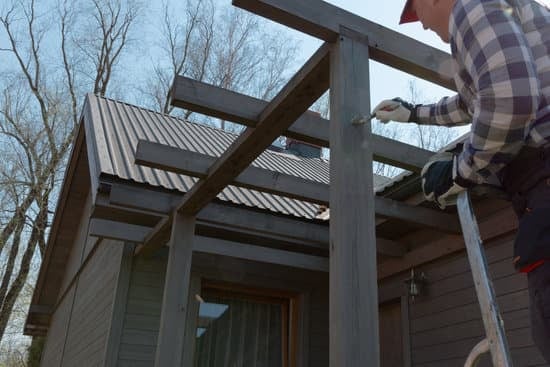Are you wondering how to get energy tax credit for home improvements? Energy tax credits are a valuable incentive for homeowners looking to make energy-efficient upgrades to their homes. By understanding what energy tax credits are and how they can benefit you, you can make informed decisions about your home improvement projects.
In this article, we will explore the eligibility requirements, documentation needed, and the process of claiming energy tax credits for various home improvements. Whether you’re considering solar panels, energy-efficient windows, insulation, or other upgrades, knowing how to take advantage of these incentives can help you save money and reduce your environmental impact.
Energy tax credits are designed to promote energy efficiency in residential properties. By making eligible improvements to your home, not only can you lower your energy bills and increase your comfort, but you may also qualify for valuable tax credits. Throughout this article, we will provide a comprehensive overview of the benefits of getting energy tax credits for home improvements and guide you through the process of determining eligibility and claiming the credits.
Understanding the importance of energy efficiency in home improvements is crucial for maximizing the benefits of energy tax credits. Whether it’s reducing your carbon footprint or enjoying long-term cost savings, there are numerous advantages to making energy-efficient upgrades to your home. By exploring the eligible home improvements for energy tax credits and learning about their contributions to energy efficiency, homeowners can make informed choices that align with their goals for sustainability and financial savings.
Eligible Home Improvements for Energy Tax Credits
When it comes to making home improvements, it’s important to consider not only the immediate benefits but also the long-term impact on energy efficiency. Fortunately, there are several eligible home improvements that qualify for energy tax credits, providing homeowners with an opportunity to save money while reducing their environmental footprint. Here is a list of home improvements that qualify for energy tax credits:
1. Solar Panels: Installing solar panels on your property can significantly reduce your reliance on traditional energy sources and qualify you for a tax credit.
2. Energy-Efficient Windows: Upgrading to energy-efficient windows can improve insulation and reduce heat transfer, making your home more energy efficient.
3. Insulation: Adding or improving insulation in your home can help regulate indoor temperatures and reduce the need for excessive heating or cooling.
4. Energy-Efficient Heating and Cooling Systems: Upgrading to energy-efficient HVAC systems can contribute to significant energy savings and make you eligible for tax credits.
5. Energy-Efficient Doors: Installing doors with proper insulation and weather-stripping can also contribute to energy efficiency and tax credit eligibility.
Each of these eligible improvements plays a crucial role in enhancing the overall energy efficiency of your home, leading to reduced utility costs and a smaller environmental impact. When considering which improvements to pursue, it’s essential to evaluate not only the upfront cost but also the potential long-term savings and benefits in terms of tax credits.
Requirements for Qualifying for Energy Tax Credits
To qualify for energy tax credits for home improvements, homeowners must meet certain eligibility requirements set by the government. One of the key requirements is that the home improvements must be made to a primary residence in the United States; second homes and rental properties are not eligible for these tax credits. Additionally, the improvements must meet the standards set by the Department of Energy and be completed before the specified deadlines to qualify for the credit.
Another important consideration is that different home improvements have varying credit limits. For example, installing solar panels may allow homeowners to claim a higher amount of tax credit compared to other energy-efficient upgrades. Homeowners should research and understand the maximum credit available for each improvement in order to maximize their potential savings.
Furthermore, it’s essential for homeowners to ensure that the products installed during home improvements are certified as energy-efficient by recognized authorities. This includes looking for ENERGY STAR certification or other relevant industry standards. Ensuring that all products and installations meet these criteria is crucial for claiming energy tax credits during tax filing season.
In addition to meeting specific criteria for each improvement, homeowners should also keep in mind that they need to have proper documentation and evidence to support their claims. This includes retaining receipts, product certifications, and any other relevant paperwork related to the home improvements. Without adequate documentation, homeowners may face challenges when claiming energy tax credits with the IRS. Therefore, it’s important to stay organized and keep track of all necessary documents throughout the process.
Documentation and Evidence Needed
When it comes to claiming energy tax credits for home improvements, having the right documentation and evidence is crucial. The Internal Revenue Service (IRS) requires homeowners to provide proof of the qualifying improvements in order to claim the credits on their tax returns. Some of the essential documents and evidence needed include receipts, invoices, and manufacturer certifications for the purchased products or installed systems.
It’s important to keep detailed records of all expenses related to the eligible home improvements. This includes not only the cost of materials and equipment but also any expenses incurred for labor or installation. Having accurate documentation will help support your claims and ensure that you receive the full credit you are entitled to.
In addition to receipts and invoices, homeowners should also gather manufacturer certifications or other relevant product information that demonstrates compliance with energy efficiency standards. For example, if you’ve installed energy-efficient windows or doors, make sure to keep the manufacturer’s certification statement, which certifies that the product meets the energy efficiency requirements set by the IRS.
| Documentation Needed | Evidence Required |
|---|---|
| Receipts | Invoices |
| Labor/Installation Expenses | Manufacturer Certifications |
How to Claim Energy Tax Credits
| Eligible Home Improvements for Energy Tax Credits | Data |
|---|---|
| Solar Panels | Installing solar panels can qualify for a tax credit that covers 26% of the total cost, including installation. This renewable energy option allows homeowners to generate their own electricity and reduce their reliance on traditional power sources. |
| Energy-Efficient Windows | Upgrading to energy-efficient windows can also make homeowners eligible for a tax credit of up to $200. These windows help prevent heat loss, reduce noise, and decrease UV damage to furniture and flooring. |
| Insulation | Improving insulation in the home can result in a tax credit covering up to 10% of the cost, with a maximum credit amount available. Proper insulation helps regulate indoor temperature and reduces energy consumption for heating and cooling. |
To claim energy tax credits for home improvements, it is vital to understand what types of improvements are eligible and how they contribute to overall energy efficiency. Some of the most common eligible home improvements include solar panels, energy-efficient windows, and insulation.
Solar panels are an exceptional investment as they allow homeowners to generate their own clean electricity and potentially reduce their dependence on traditional power sources. Not only do they contribute to energy savings but also have long-term environmental benefits.
Energy-efficient windows play a crucial role in preventing heat loss during winter months and reducing the strain on air conditioning systems during summer. They also offer better insulation against noise and UV damage, providing multiple benefits for homeowners looking to enhance energy efficiency.
Lastly, improving insulation in the home can lead to significant energy savings by helping regulate indoor temperature more effectively. By reducing the need for constant heating or cooling, proper insulation contributes not only to financial savings but also reduces overall energy consumption.
Available Incentives and Rebates
When considering energy-efficient home improvements, it’s essential for homeowners to be aware of the various incentives and rebates available to them. These programs can help offset the initial cost of upgrades and provide additional financial benefits. Here are some available incentives and rebates for energy-efficient home improvements:
- Federal Tax Credits: The federal government offers tax credits for certain energy-efficient improvements, such as solar panels, geothermal heat pumps, and small wind turbines. Homeowners can claim up to a certain percentage of the cost of these upgrades on their federal income taxes.
- State and Local Programs: Many states and local municipalities offer their own incentives and rebates for energy-efficient home improvements. These can include cash rebates, low-interest loans, or even property tax incentives for installing qualifying upgrades. Check with your state or local energy office to see what programs are available in your area.
- Utility Company Incentives: Some utility companies provide incentives for making energy-efficient upgrades to your home. These may come in the form of rebates for purchasing energy-efficient appliances, insulation, or HVAC systems.
Taking advantage of these available incentives and rebates can significantly reduce the out-of-pocket costs associated with making energy-efficient home improvements. By maximizing financial benefits through these programs, homeowners can make smart investments in their homes while also contributing to a more sustainable future.
In addition to financial savings, participating in these programs can also contribute to environmental conservation efforts by reducing overall energy consumption. By taking advantage of available incentives and rebates, homeowners can play a role in promoting sustainable living practices within their communities.
Ultimately, understanding and utilizing available incentives and rebates for energy-efficient home improvements is key to maximizing the overall benefit of these upgrades. As homeowners plan their projects and look into claiming tax credits, exploring these additional opportunities for financial assistance should be an integral part of the process.
Common Mistakes to Avoid
Failing to Keep Accurate Records and Receipts
One of the most common mistakes homeowners make when claiming energy tax credits for home improvements is not keeping accurate documentation. Without proper records and receipts, it can be challenging to prove the eligibility of the improvements for tax credits. It’s important to organize and store all documentation related to the energy-efficient upgrades, including receipts for materials and labor, manufacturer certifications for energy-efficient products, and any other relevant paperwork.
Not Understanding Eligibility Requirements
Another mistake to avoid is not fully understanding the eligibility requirements for claiming energy tax credits. Each type of improvement, such as solar panels or insulation, has specific criteria that must be met in order to qualify for the credit. Homeowners should thoroughly research and understand these requirements before making any upgrades to ensure that they meet the necessary criteria for claiming tax credits.
Waiting Until the Last Minute to Claim Credits
Many homeowners make the mistake of waiting until tax filing season to think about claiming energy tax credits. However, it’s important to plan ahead and gather all necessary documentation throughout the year as improvements are made. By waiting until the last minute, homeowners may miss out on potential incentives or rebates due to oversight or lack of time. Planning ahead and staying organized can help maximize the financial benefits of energy-efficient home improvements.
Avoiding these common mistakes can help homeowners successfully claim energy tax credits for their home improvements, ultimately leading to long-term savings and a more environmentally friendly living space. By staying informed, organizing documentation, and planning ahead, homeowners can take advantage of available incentives while contributing to a more sustainable future.
Additional Considerations
Long-Term Savings and Environmental Benefits
Making energy-efficient home improvements not only qualifies homeowners for tax credits but also provides long-term financial savings. By reducing energy consumption through improvements such as solar panels, insulation, and energy-efficient windows, homeowners can lower their utility bills significantly. Over time, these savings can offset the initial cost of the improvements, making them a sound investment for the future.
In addition to financial benefits, energy-efficient home improvements also have a positive impact on the environment. By minimizing energy usage, homeowners can reduce their carbon footprint and contribute to environmental conservation efforts. This means lower greenhouse gas emissions and a decreased reliance on non-renewable energy sources, which ultimately helps in preserving the planet for future generations.
Continuing Energy Efficiency Beyond Tax Credits
While claiming energy tax credits for home improvements is a great incentive, it’s important for homeowners to continue prioritizing energy efficiency even after the tax benefits have been realized. This can be achieved by adopting sustainable habits such as reducing electricity usage, implementing water-saving practices, and investing in smart home technology that promotes efficient energy management.
Furthermore, staying informed about new advancements in energy-efficient technologies and practices can help homeowners continually improve their living spaces while also contributing to a sustainable future. Regular maintenance of home systems and appliances can also ensure that they operate efficiently, further maximizing the long-term benefits of energy-efficient choices beyond tax credits. By embracing a holistic approach to sustainability, homeowners can create lasting positive impacts on both their finances and the environment.
Conclusion
In conclusion, taking advantage of energy tax credits for home improvements can not only lead to financial savings but also contribute to a more sustainable and environmentally-conscious lifestyle. By understanding the eligibility requirements, documenting the necessary evidence, and following the proper procedures for claiming these credits, homeowners can benefit from valuable incentives while making their homes more energy-efficient.
It is important for homeowners to recognize the significance of energy tax credits in promoting energy efficiency and reducing overall energy consumption. Through the available incentives and rebates, individuals have the opportunity to make significant strides towards a greener and more cost-effective living environment. Therefore, it is crucial for readers to start planning their energy-efficient home improvements and take full advantage of these tax credits.
As we move towards a more sustainable future, it is essential for homeowners to consider the long-term benefits of energy-efficient home improvements beyond just tax credits. By reducing energy consumption through eligible upgrades, individuals can experience lower utility bills and contribute positively to environmental conservation efforts. Therefore, I encourage readers to explore available incentives, plan their home improvement projects accordingly, and actively participate in creating a more energy-efficient future for themselves and the community as a whole.
Frequently Asked Questions
How Do I Claim Energy Credit on My Taxes?
You can claim energy credits on your taxes by filling out the appropriate forms, such as Form 5695 for residential energy credits. These credits are available for homeowners who make energy-efficient improvements to their homes, such as installing solar panels or energy-efficient windows and doors.
Be sure to keep all receipts and documentation of the improvements made to support your claim.
Are Home Energy Improvements Tax Deductible?
Home energy improvements may be tax deductible under certain circumstances. For example, if you made qualifying energy-efficient upgrades to your home, such as adding insulation, installing a new energy-efficient heating or cooling system, or upgrading to energy-efficient windows and doors, you may be eligible for a tax credit or deduction.
It’s important to check with the IRS or a tax professional to determine what types of improvements qualify and how to claim them on your taxes.
Can You Claim Home Improvements on Your Taxes?
In some cases, you can claim home improvements on your taxes if they qualify for certain deductions or credits. Typically, home improvements that increase the energy efficiency of your home, such as installing solar panels or geothermal heat pumps, may be eligible for a tax credit.
However, general home repairs and maintenance usually do not qualify for tax benefits unless they are related to making your home more energy-efficient. It’s important to review the specific guidelines from the IRS or consult with a tax professional regarding any potential tax benefits related to home improvements.

I’m thrilled to have you here as a part of the Remodeling Top community. This is where my journey as an architect and remodeling enthusiast intersects with your passion for transforming houses into dream homes.





